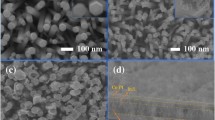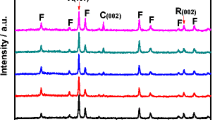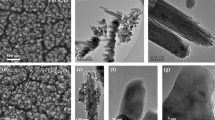Abstract
In order to obtain a high photoelectrochemical performance, co-catalysts loading is the most commonly used way, which can facilitate reactions and suppress the charge recombination. In this paper, a novel composite of ZnO/Ti3C2TX photoanode was fabricated by a facile spin coating of precipitating Ti3C2TX (MXene) flakes onto the surface of ZnO, as co-catalyst for enhanced photoelectrochemical (PEC) water splitting. Under simulated sunlight, the optimum composite of ZnO/Ti3C2TX photoanode showed the photocurrent density as 1.2 mA cm−2 at 1.23 VRHE, which is 1.4 times higher than that of pristine ZnO without Ti3C2TX co-catalyst (0.83 mA cm−2 at 1.23 VRHE). The ZnO/Ti3C2TX photoanode showed a photoconversion efficiency of 0.32% and maintained a stable photocurrent over 2000s. The Ti3C2TX (MXene) flakes as co-catalyst to promote the charge transfer and accelerates the reaction kinetics in ZnO/Ti3C2TX photoanode. This work delivers a two-dimensional (2D) material Ti3C2TX (MXene) as co-catalyst for enhanced ZnO photoanode PEC water splitting.







Similar content being viewed by others
References
Walter H, Warren E, McKone J, Boettcher S, Mi Q, Santori E, Lewis N (2010) Solar water splitting cells. Chem Rev 110:6446–6473. https://doi.org/10.1021/cr1002326.2010.110.11
Kalanur S, Duy L, Seo H (2018) Recent progress in photoelectrochemical water splitting activity of WO3 photoanodes. Top Catal 61:1043–1076. https://doi.org/10.1007/s11244-018-0950-1
Yan D, Xue Z, Chen F, Liu X, Yang Z, Pei Y, Zhou S, Zhao C (2021) (002) facets exposed and controllable thickness of CdS nanobelts drive desirable hydrogen-adsorption free energy (△GH) for boosting visible-light photocatalytic performance. Catal Sci Technol. https://doi.org/10.1039/D1CY01385H
Fujishima A, Honda K (1972) Electrochemical photolysis of water at a semiconductor electrode. Nature 238:37–38. https://doi.org/10.1038/238037a0
Chae S, Sudhagar P, Fujishima A, Joo O, Hwang Y (2015) Improved photoelectrochemical water oxidation kinetics using a TiO2 nanorod array photoanode decorated with graphene oxide in a neutral pH solution. Phys Chem Chem Phys 17:7714. https://doi.org/10.1039/c4cp05793g
Najaf Z, Nguyen D, Chae S, Joo O, Nguyen V, Le Q, Rahman G (2020) Recent trends in development of hematite (a-Fe2O3) as an effificient photoanode for enhancement of photoelectrochemical hydrogen production by solar water splitting. Hydrogen Energy. https://doi.org/10.1016/j.ijhydene.2020.07.111
Patial S, Kumar R, Raizada P, Singh P, Nguyen D, Nguyen V (2021) Boosting light-driven CO2 reduction into solar fuels: mainstream avenues for engineering ZnO-based photocatalysts. Environ Res 197:111134. https://doi.org/10.1016/j.envres.2021.111134
Han J, Liu Z, Guo K, Wang B, Zhang X, Hong T (2015) High-effificiency photoelectrochemical electrodes based on ZnIn2S4 sensitized ZnO nanotube arrays. Appl Catal B 163:179–188. https://doi.org/10.1016/j.apcatb.2014.07.040
Zhou T, Wang J, Chen S, Bai J, Li J, Zhang Y, Li L, Xia L, Rahim M, Xu Q, Zhou B (2020) Bird-nest structured ZnO/TiO2 as a direct Z-scheme photoanode with enhanced light harvesting and carriers kinetics for highly effiffifficient and stable photoelectrochemical water splitting. Appl Catal B 267:118599. https://doi.org/10.1016/j.apcatb.2020.118599
Yang X, Wolcott A, Wang G, Sobo A, Fitzmorris R (2009) Nitrogen-doped ZnO nanowire arrays for photoelectrochemical water. Splitting Nano Lett 9:6. https://doi.org/10.1021/nl900772q
Roza L, Rahman M, Umar A, Salleh M (2015) Direct growth of oriented ZnO nanotubes by self-selective etching at lower temperature for photo-electrochemical (PEC) solar cell application. J Alloy Compd 618:153–158. https://doi.org/10.1016/j.jallcom.2014.08.113
Krunks M, Katerski A, Dedova T, Acik I, Mere A (2008) Nanostructured solar cell based on spray pyrolysis deposited ZnO nanorod array. Sol Energy Mater Sol Cells 92:1016–1019. https://doi.org/10.1016/j.solmat.2008.03.002
Nie Q, Yang L, Cao C, Zeng Y, Wang G, Wang C, Lin S (2017) Interface optimization of ZnO nanorod/CdS quantum dots heterostructure by a facile two-step low-temperature thermal treatment for improved photoelectrochemical water splitting. Chem Eng J 325:151–159. https://doi.org/10.1016/j.cej.2017.05.021
Nguyen D, Lee C, Na J, Han S, Lee U, Hwang Y (2020) Mass transport control by surface graphene oxide for selective CO production from electrochemical CO2 reduction. ACS Catal 10:3222–3231. https://doi.org/10.1021/acscatal.9b05096
Aulakh M, Pal B, Vaishnav A, Prakash N (2021) Biosynthesized monodispersed spherical Se co-catalyst nanoparticles impregnated over ZnO for 4-chloroguaiacol degradation under solar irradiations. J Environ Chem Eng 9:104892. https://doi.org/10.1016/j.jece.2020.104892
Liton M, Islam A, Kamruzzaman M, Khan M, Helal M, Rahman M (2020) Dual acceptor (N, Cu) doping effects on the electronic and optical properties of ZnO. Mater Chem Phys 242:122463. https://doi.org/10.1016/j.matchemphys.2019.122463
Shi Z, Qi X, Zhang Z, Zhang J, Guo C, Liu K, Xu W, Xu J, Zhu Z (2021) Facile synthesis of ZnO/PdSe2 core-shell heterojunction for efficient photodetector application. Chem Eng J 413:127484. https://doi.org/10.1016/j.cej.2020.127484
Yan D, Fu X, Shang Z, Liu J, Luo H (2019) A BiVO4 fifilm photoanode with re-annealing treatment and 2D thin Ti3C2TX flflakes decoration for enhanced photoelectrochemical water oxidation. Chem Eng J 361:853–861. https://doi.org/10.1016/j.cej.2018.12.146
Wei L, Deng W, Li S, Wu Z, Cai J, Luo J (2022) Sandwich-like chitosan porous carbon Spheres/MXene compositewith high specifific capacitance and rate performance for supercapacitors. J Bioresour Bioproducts 7:63–72. https://doi.org/10.1016/j.jobab.2021.10.001
Nguyen T, Le T, Nguyen D, Le Q, Nguyen V (2020) Recent advances in two-dimensional transition metal dichalcogenides as photoelectrocatalyst for hydrogen evolution reaction. J Chem Technol Biotechnol 95:2597–2607. https://doi.org/10.1002/jctb.6335
Naguib M, Mashtalir O, Carle J, Presser V, Lu J, Hultman L, Gogotsi Y, Barsoum M (2012) Two-dimensional transition metal carbides. ACS Nano 6:1322–1331. https://doi.org/10.1021/nn204153h.2012.6.2
Verger L, Xu C, Natu V, Cheng H, Ren W, Barsoum M (2019) Overview of the synthesis of MXenes and other ultrathin 2D transition metal carbides and nitrides. Curr Opin Solid State Mater Sci 23:149–163. https://doi.org/10.1016/j.cossms.2019.02.001
Naguib M, Kurtoglu M, Presser V, Lu J, Niu J, Heon M, Hultman L, Gogotsi Y, Barsoum M (2011) Two-dimensional nanocrystals produced by exfoliation of Ti3AlC2. Adv Mater 23:4248–4253. https://doi.org/10.1002/adma.201102306
Jiang Q, Wang H, Wei X, Wu Y, Gu W, Hu L, Zhu C (2020) Effificient BiVO4 photoanode decorated with Ti3C2TX MXene for enhanced photoelectrochemical sensing of Hg (II) ion. Anal Chim Acta 1119:11–17. https://doi.org/10.1016/j.aca.2020.04.049
Wang W, Hood Z, Zhang X, Ivanov I, Bao Z, Su T, Jin M, Bai L, Wang X, Zhang R, Wu Z (2020) Construction of 2D BiVO4-CdS-Ti3C2Tx heterostructures for enhanced photo-redox activities. ChemCatChem 12:3496–3503. https://doi.org/10.1002/cctc.202000448
Chang H, Shang Z, Kong Q, Liu P, Liu J, Luo H (2020) α-Fe2O3 nanorods embedded with two-dimensional 0 0 1 facets exposed TiO2 flflakes derived from Ti3C2TX MXene for enhanced photoelectrochemical water oxidation. Chem Eng J 370:314–321. https://doi.org/10.1016/j.cej.2019.03.181
Yin H, Wang Y, Ma L, Zhang S, Yang B, Jiang R (2022) Effect of surface-deposited Ti3C2Tx MXene on the photoelectrochemical water-oxidation performance of iron-doped titania nanorod array. Chem Eng J 431:134124. https://doi.org/10.1016/j.cej.2021.134124
Chen Y, Wang L, Gao R, Zhang Y, Pan L, Huang C, Liu K, Chang X, Zhang X, Zou J (2019) Polarization-Enhanced direct Z-scheme ZnO-WO3-x nanorod arrays for effiffifficient piezoelectric-photoelectrochemical Water splitting. Appl Catal B 259:118079. https://doi.org/10.1016/j.apcatb.2019.118079
Wang T, Lv R, Zhang P, Li C, Gong J (2014) Au nanoparticle sensitized ZnO nanopencil arrays for photoelectrochemical water splitting. Nanoscale. https://doi.org/10.1039/c4nr03735a
Han H, Karlicky F, Pitchaimuthu V, Chen A (2019) Highly ordered N-doped carbon dots photosensitizer on metal-organic framework-decorated ZnO nanotubes for improved photoelectrochemical water splitting. Small 15:1902771. https://doi.org/10.1002/smll.201902771
Hou T, Johar M, Pandikumar A, Boppella R, Lee L (2020) Vertically aligned one-dimensional ZnO/V2O5 core–shellhetero-nanostructure for photoelectrochemical water splitting. J Energy Chem 49:262–274. https://doi.org/10.1016/j.jechem.2020.02.004
Lin Y, Hsu Y, Chen Y, Chen L, Chen S, Chen K (2012) Visible-light-driven photocatalytic carbon-doped porous ZnO nanoarchitectures for solar water-splitting. Nanoscale 4:6515–6519. https://doi.org/10.1039/c2nr31800h
Li H, Dong W, Zhang J, Xi J, Du G, Ji Z (2018) MoS2 nanosheet/ZnO nanowire hybrid nanostructures for photoelectrochemical water splitting. J Am Ceram Soc 101:3989–3996. https://doi.org/10.1111/jace.15540
Zhang H, Tian W, Li Y, Sun H, Wang S (2013) A comparative study of metal (Ni Co, or Mn)-borate catalysts and their photodeposition on rGO/ZnO nanoarrays for photoelectrochemical water splitting. J Name 00:1–3. https://doi.org/10.1039/x0xx00000x
Guo C, Dong Y, Yang H, Li C (2013) Graphene quantum dots as a green sensitizer to functionalize ZnO nanowire arrays on F-doped SnO2 glass for enhanced photoelectrochemical water splitting. Adv Energy Mater 3:997–1003. https://doi.org/10.1002/aenm.201300171
Babu E, Rani B, Ravi G, Kim S, Jeon H (2018) Vertically aligned Cu-ZnO nanorod arrays for water splitting applications. Mater Lett 222:58–61. https://doi.org/10.1016/j.matlet.2018.03.187
Gasparotto A, Maccato C, Sada C, Carraro G, Altantzis T, Barreca D (2019) Controlled surface modification of ZnO nanostructures with amorphous TiO2 for photoelectrochemical water splitting. Ad Sustainable Syst 3:1900046. https://doi.org/10.1002/adsu.201900046
Acknowledgements
The authors are grateful for the financial support of the National Natural Science Foundation of China (21676226), Key Research and Development Program in Hunan Province (2019GK2041), Hunan Key Laboratory of Environment Friendly Chemical Process Integrated Technology and Collaborative Innovation Center of New Chemical Technologies for Environmental Benignity and Efficient Resource Utilization. The science and technology innovation Program of Hunan Province (2021RC2089), Guangdong Basic and Applied Basic Research Foundation (2021A1515110136).
Author information
Authors and Affiliations
Corresponding authors
Additional information
Publisher's Note
Springer Nature remains neutral with regard to jurisdictional claims in published maps and institutional affiliations.
Rights and permissions
About this article
Cite this article
Zhong, C., Shang, Z., Zhao, C. et al. Co-Catalyst Ti3C2TX MXene-Modified ZnO Nanorods Photoanode for Enhanced Photoelectrochemical Water Splitting. Top Catal 66, 12–21 (2023). https://doi.org/10.1007/s11244-022-01619-0
Accepted:
Published:
Issue Date:
DOI: https://doi.org/10.1007/s11244-022-01619-0




